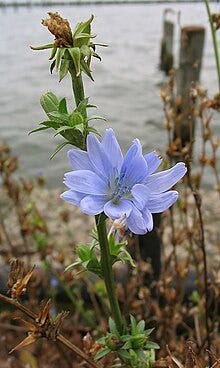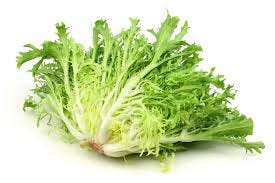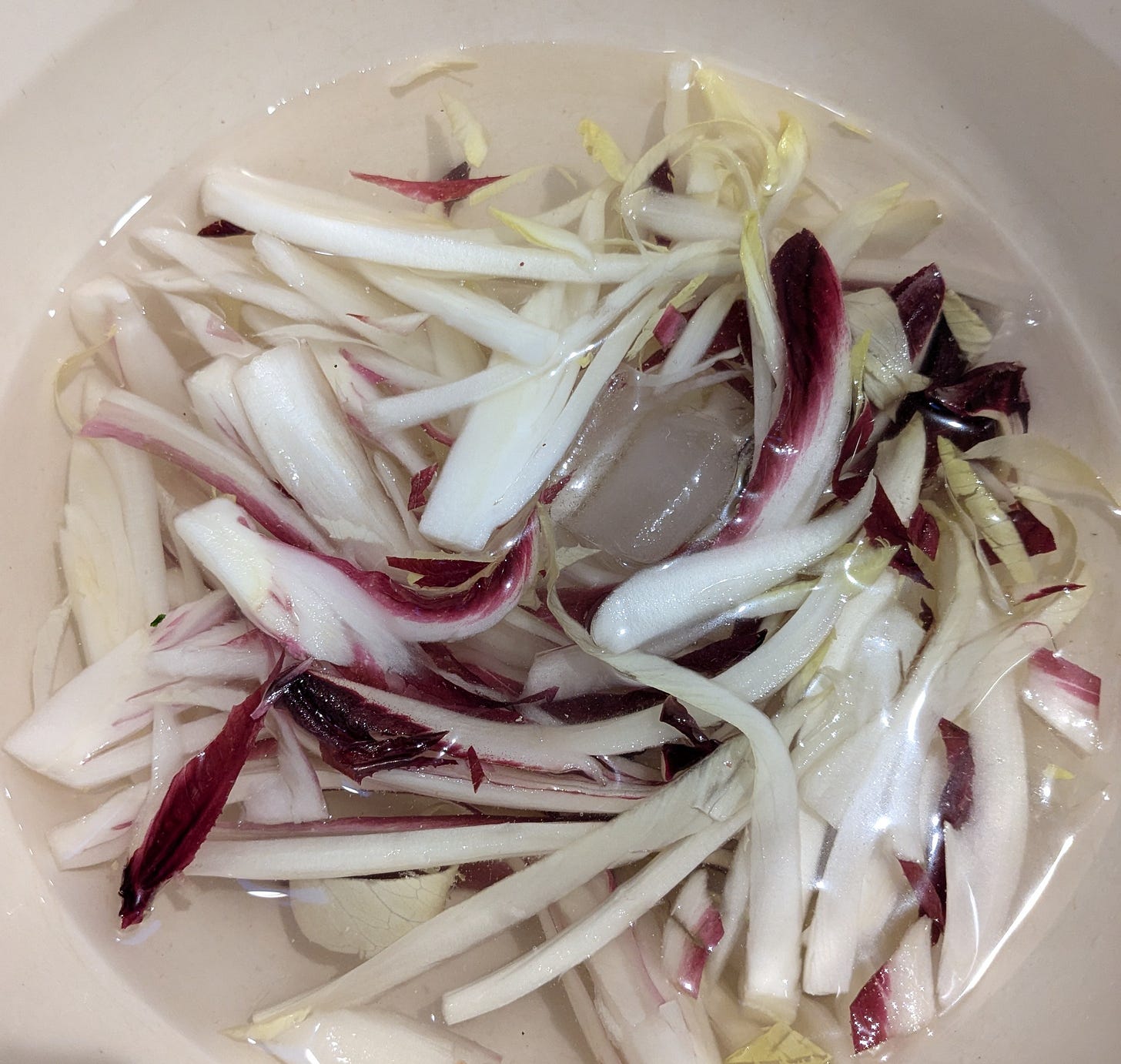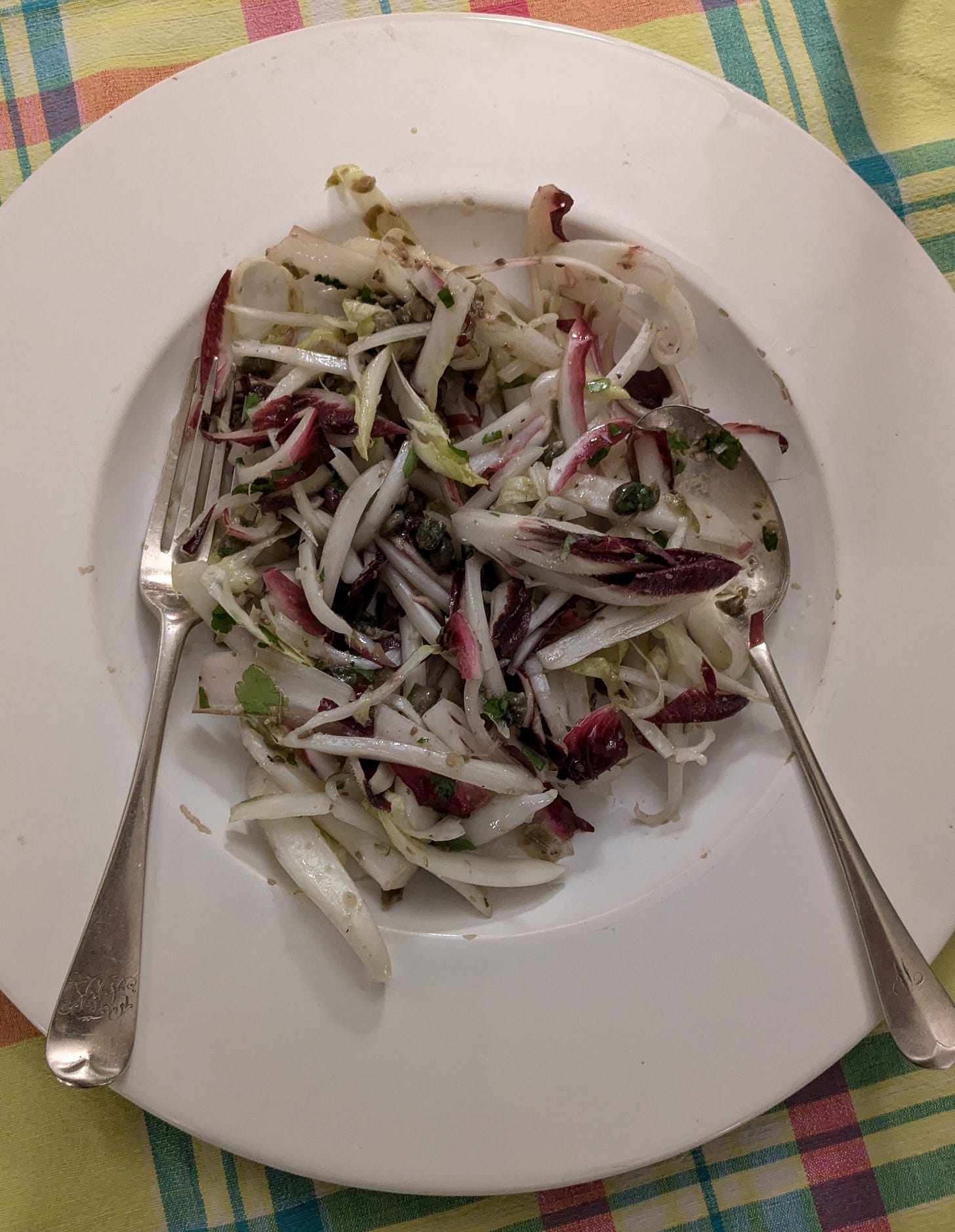Untangling a tangled winter salad
A recipe for Puntarelle alla Romana made with Belgian endive
It’s rare, these days of hydroponic, indoor, and poly-tunnel farming, to find any fruit or vegetable that isn’t available year round.
Say ‘Ciao’ to winter season exclusive puntarelle.
Member of the large Cichorium genus of wild and cultivated bitter greens, puntarelle are sought after at this time of year - by Roman households and global restaurant diners who count themselves savvy.
If ‘bitter’ gives you pause, I hope to convert you to these salad leaves - or the excellent substitute I propose if you can’t come by any. At this energy-sapping, frigid, colourless time of year when, to be frank, it’s a drag to conjure up even a cup of coffee, a salad of puntarelle served with warm crusty bread is a good and quickly-contrived stand-alone start to a meal. At the same time, the bitterness intrinsic in them makes a cleansing foil to a rich meat like pork, or duck, or gamey goose. It also balances out anything swimming in a cream sauce.
The Cichorium family of which it is a member is extensive. It includes dandelion, endive, castelfranco, chioggia, escarole, frisée, sugarloaf, and treviso. That’s before we delve into the radicchio subgroup.
You probably recognise blue-flowered wild chicory, a weed growing along verges and in meadows. In France, you may even have eaten its blanched buds in omelettes, much as dandelion buds are cooked. After Napoleon initiated the ‘Continental Blockade’ in 1808 which deprived the French of their coffee, its root was roasted and ground down to use as a coffee substitute. Even today, many French still prefer their coffee with chicory. They think it’s good for their health and adds a better flavour besides. Discuss.
In the 19th century in American states under French cultural influence like Louisiana, chicory was added to coffee. For some it has become a preferred substitute. If you want to try it, go to Cafe du Monde in New Orleans. (Also order their beignets…) During the Civil War, with trade disruptions and blockades preventing delivery of coffee, roasting wild chicory root to drink instead became common. (For an appreciation of the effect of a contemporary ‘blockade’, just substitute ‘trade tariff’.)
There are two types of puntarelle. Puntarelle di Gaeto from Lazio and also known as ‘asparagus chicory’, ‘volcanic chicory’ and cicoria di catalogna, has long shoots that curl up as soon as you trim them. Puntarelle di Galatina, from Puglia, has shorter shoots that refuse to curl up, whatever your culinary skills.
The name ‘chicory’ causes confusion. Until relatively recently, it was given to what is now referred to ‘Belgian endive’ (though not in Belgium, where it is called ‘witloof’). ‘Endive’ was previously the name for the bitter salad head, grass green in its outer leaves, lemon yellow in its milder-tasting centre, that looks like it’s been given a radical perm or violent electric shock. That is now known as ‘curly endive’. Or sometimes chicory. (Are you still with me?)
It makes the salad that, dressed in a mustardy vinaigrette and turned over with copious crispy bacon bits, makes what appears on French menus as frisée aux lardons. It was once ubiquitous in a wide range of mainstream English stores and unpretentious ‘panda bowl’ English street markets. (This expression comes from the barrow boys’ cry, “A pand a bowl!” or “Any bowl a pand!”, the Cockney pronunciation of ‘pound’ being ‘pand’…I’m happy to elaborate if necessary - just drop a Comment). But it’s years since I’ve seen any in either source.
The prodigious Cichorium family produces all these bitter winter greens (though endive are now available year round). Puntarelle look not unlike the deeply serrated leaves of a dandelion but in colour are closer to the pale green of the Belgian endive. The name ‘Puntarelle’ is thought to be an affectionate diminutive by inhabitants of Rome of ‘punta’, a reference to the pointed tip of the asparagus for which the cicoria asparago is named.
To turn their interiors a delicate shade, the plants are grown in the autumn then dug up at the start of winter, their leaves and stems trimmed, the puntarelle then replanted, covered, until new and delicate shoots are forced into leaf.
And you wonder why good food can be expensive?
The more bitter dark external leaves of the plants can be cooked by turning them over and over until limp in a large lump of butter in which a finely chopped clove of garlic has been sweated slowly for five minutes before you add them.
It’s most likely you live somewhere it will be very hard to find puntarelle. Not to worry, Belgian endive are a perfect substitute. Buy a few red ones if they’re available to add to the white for visual glory.
Those who do have access to puntarelle prepare the younger leaves for a salad by soaking them in iced water until they begin to curl, in a method we shall steal for our endives.
And that’s your big trick for today’s recipe.
Trim the root and discard the sliver, leaving most of the root attached to the leaves. Cut the endive down its middle lengthways then repeat, to turn each half into a quarter. Then slice the quarters thinly from top to bottom. Submerge the slices in a bowl of water into which you’ve cast a tray of ice cubes, for an hour or two - or overnight, even, to curl up. If they haven’t, who cares? When you’re ready to serve, drain the leaves and pat as dry as possible on a clean kitchen towel or in a spinner. Then dress them as follows.
Having held your attention to this point, I realise I now stand in danger of losing it. The key dressing is made of garlic, oil, vinegar, capers - and anchovies. If you need convincing that I really do understand how you may feel about anchovies, read Anchovies - the Marmite of the sea, which will tell you more than may want to know about these blameless fish. As I say there, they are the culinary equivalent of the Wonderbra: they add body to food. So if you use them, keep mum. Like Wonderbras, their presence will not be discerned by most.
Serves 4-6
8-10 Belgian endives, a mix of white and red if possible. If you’ve found a puntarelle source, you’ll need 1 to 2 heads, 575g/20 oz
8 oil-packed anchovies, drained
2 medium or large garlic cloves, peeled and finely chopped
½ teaspoon salt, or more to taste (anchovies are very salty!)
3 tablespoons red wine vinegar
5 tablespoons extra-virgin olive oil
½ cup fresh flat-leaf parsley leaves (optional)
3 tablespoons capers, drained and roughly chopped
Freshly ground black pepper
On a cutting board, finely chop together the anchovies, garlic, and salt, then again with the side of the knife you’ve used to chop the garlic. Then use a fork, mashing and scraping over and over to make a rough paste. Scrape with your earlier knife into a bowl and add the vinegar. Whisk until it is absorbed then add the oil in a thin stream, whisking constantly, until emulsified. Whisk in the capers and pour over the endives and toss thoroughly. Season to taste if necessary then sprinkle over the parsley if using.








Oh, how I adore your writing of recipes! Yes, I sometimes recreate the recipe, but sometimes its the simple 'reading' of your works that is satisfaction, indeed. (But, I'll give it a try!)
Love Belgian endive!